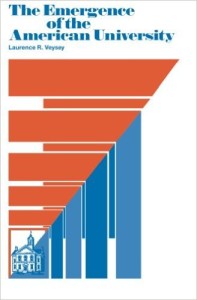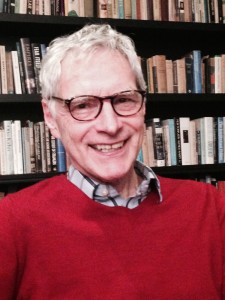Classics Series: Thomas Bender on Laurence R. Veysey’s The Emergence of the American University (1965).
The Emergence of the American University by Laurence Veysey was published fifty years ago, yet it remains an indispensible work on American higher education. The research that went into it is prodigious. At 505 pages, it is nonetheless a trimmed down version of a monumental dissertation at Berkeley—1300 pages in five volumes. Because I have over the years written about the American university past and present, it has been an invaluable resource for me. But in respect to its contribution to my development as an intellectual historian, its importance is more methodological than topical. It taught me that the study of intellectual history must focus on institutions as well as people and ideas. I cannot say that this was the only influence in this direction, but it was a powerful one.[i]
When I began my graduate career, I was immediately taken by and influenced by a key, even founding, work in American Studies: Henry Nash Smith’s Virgin Land: The American West as Symbol and Myth (1950). My first seminar paper (later to be my first article) built on Smith, though reversing his focus: Rather than looking west or to nature, I looked east, to cities. I examined one of his key writers, James Fenimore Cooper, who, I discovered, prompted by the Anti-Rent War in upstate New York, which he chronicled in his “Littlepage Novels,” made him despair of rural virtue and nature. In the months before his death in 1851, he began a study of the merchant class of Manhattan, looking to them for the political virtue he had earlier supposed belonged towns and cultivated fields, like Cooperstown.[ii]
Later, my dissertation, especially in my initial prospectus, was significantly built upon Smith’s most widely influential student, Leo Marx, who authored another American Studies classic of the time: The Machine in the Garden: Technology and the Pastoral Ideal in America (1964). But in revising the dissertation into a book, I focused increasingly on institutions as shapers, carriers, and sometimes the incarnation of ideas and means of action. The book version, but not the dissertation, even had “institution” in its title: Toward an Urban Vision: Ideas and Institutions in Nineteenth-Century America (1975).[iii]
The different structures  of intellectual/cultural institutions, their succession, and implication for intellectual practices became framework for New York Intellect: A History of Intellectual Life in New York City, from 1750 to the Beginnings of Our Own Time
of intellectual/cultural institutions, their succession, and implication for intellectual practices became framework for New York Intellect: A History of Intellectual Life in New York City, from 1750 to the Beginnings of Our Own Time
(1987); and later in Intellect and Public Life: Essays on the Social History of Academic Intellectuals in the United States (1993), and other of my publications in intellectual history over the years.
Veysey had pointed me in the right direction. However, I gradually came to think that while he had the right idea, he structured his book in a way that misused the idea, limiting its explanatory power. He divided his book into Part One, “Rival Conceptions of the Higher Learning, 1865-1910,” and Part Two, “The Price of Structure, 1890-1910.” But the relation of these components to each other was unclear. He told two stories, one institutional, the other ideational or ideological. The narrative in Part One was rich in the proliferation of various visions of an American research university. Many agenda-setting academic flowers were blooming.
Part Two was a different story. If Part One was a progressive flowering of ideas, the second half of the book, which overlapped the chronology of the first, focused on institutional development. He focused on the emergence of three clusters of research universities in the northeast, the mid-west, and the far west. The energy in this part comes from “administration,” not ideas. The leadership and outcome looked strikingly similar to the capitalist structure of industry. He repeatedly made reference to the baleful influence of trustee/business values, but he did not pursue this theme in the archives.
The two parts are like two books, with some of the same characters, but in different dress. In his Preface, he indicated that there are two kinds of “academic conflict”: the debate over “purpose” and that over “the kind and degree of control.” While it seems that these two conflicts belong in the same arena, he divided them into the two parts. Moreover, he decided that the two parts required different methods. The two basic types of cleavage, he explained, “require analysis by different methods: those of intellectual history in the first case and in informal version of structural-functional analysis in the second.[iv]
This separation of ideas and institutions (or structure) largely undermined his essential and important insight that both of these aspects of intellectual life had to be addressed—and integrated. In a later generation of scholarship an even more damaging diminution of the role of institutions accompanied the “linguistic turn” and poststructuralist analyses more generally. Unlike the philosophical arguments marshaled by poststructuralists to justify their narrow analysis, Veysey’s strategy seems to have emerged, at least in part, from the scale of his project and the mass of sources. With so much material, he had to divide it some way and he did so in a mechanical division of labor. Had he used a conventional temporal arrangement of his material he probably would have sustained his thesis and enriched the causal analysis of ideas and institutions in this account of impressive beginnings and a disappointing outcome.
He concluded that “the basic pattern of the university, as it clearly revealed itself soon after 1890, was that of a success-oriented enterprise. . . .As more Americans began to accept the new institution, occasions for a measured appraisal of the move toward standardization and assimilation grew fewer and fewer. The promise of numbers, influence, and respectability could not seriously be ignored or resisted in high places.”[v] Yet, he added, the university “did not go the whole way into the American mainstream. Pockets of strenuous dedication to goals that were absurdly unpopular . . . persisted in odd places with the institution.”[vi]
If this book, like all books, is imperfect, I should not close on a critical note. Let me return to its value to me and to the profession. At a time when there were few professionally written and non-celebratory histories of single universities, let alone the system of research universities in the United States, he produced a wonderfully ambitious synthesis. My worry about his structure and method helped me, and perhaps others, think about method at a time when intellectual history was being challenged by social history. And his account of the emergence of the modern universit
[i] An essay by my dissertation adviser pushed me in the same direction. See Wilson Smith, “John Locke in the Great Unitarian Controversy,” Harold M. Hyman and Leonard W. Levy, eds. Freedom and Reform: Essays in Honor of Henry Steele Commager
(New York: Harper & Row, publishers, 1967), 78-100, esp. p. 79.
[ii] Thomas Bender, James Fenimore Cooper and the City, New York History, 51 (1971), 287-305
[iii] The title of the dissertation was “The City Discovered.”
[iv] Laurence R. Veysey, The Emergence of the American University (Chicago: University of Chicago Press, 1965), viii.
[v] Ibid., 439.
[vi] Ibid., 441-2.
Thomas Bender has been on the faculty of NYU since 1974 and will be retiring next year as University Professor of the Humanities and Professor  of History. For the first fifteen or so years, his colleagues did not allow him to teach a formal course in intellectual history, which may have been a good thing. He brought the sensibility of an intellectual historians to a variety of courses and research projects, including beyond those named in the review, Community and Social Change in America (1978), Universities and Cities (1988), The Unfinished City: New York and the Metropolitan Idea (2002), The Anti-Slavery Debate (1992), among others. He has written historiographical essays and articles appraising various directions in historical writing and the relation of professional history to the larger public.
of History. For the first fifteen or so years, his colleagues did not allow him to teach a formal course in intellectual history, which may have been a good thing. He brought the sensibility of an intellectual historians to a variety of courses and research projects, including beyond those named in the review, Community and Social Change in America (1978), Universities and Cities (1988), The Unfinished City: New York and the Metropolitan Idea (2002), The Anti-Slavery Debate (1992), among others. He has written historiographical essays and articles appraising various directions in historical writing and the relation of professional history to the larger public.

0